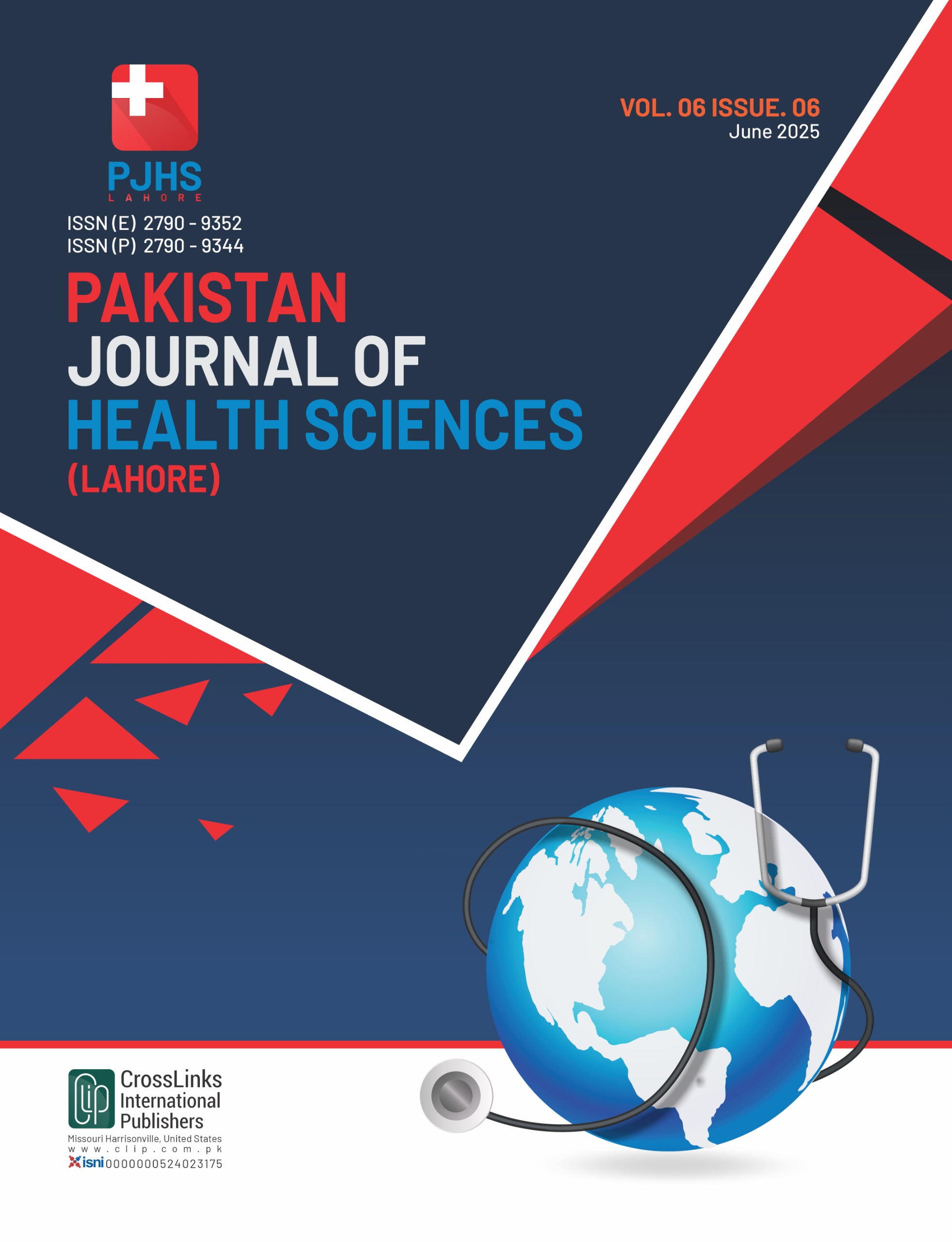Labor Augmentation in Primigravida: A Comparative Evaluation of Drotaverine and Tramadol
Labor Augmentation in Primigravida
DOI:
https://doi.org/10.54393/pjhs.v6i6.3153Keywords:
Drotaverine Hydrochloride, Tramadol, Active Labor, Cervical Dilation, Primigravida, Maternal Outcomes, Neonatal OutcomesAbstract
Prolonged labor increases maternal and fetal risks. Pharmacological agents such as Drotaverine hydrochloride and Tramadol have been utilized to shorten the duration of labor by facilitating cervical dilation and uterine activity. However, comparative evidence regarding their efficacy and safety remains limited. Objective: To compare the effectiveness of Drotaverine hydrochloride and Tramadol in reducing the duration of active labor in primigravida women, and to assess associated maternal and neonatal outcomes. Methods: This quasi-experimental study was conducted at the Department of Obstetrics and Gynecology, Niazi Medical and Dental College, Sargodha. A total of 146 primigravida women in active labor were divided into two groups (n=73 each) using non-probability consecutive sampling. Group A received intravenous Drotaverine hydrochloride (40 mg every 2 hours, up to 3 doses), while Group B received intramuscular Tramadol (100 mg, single dose). Duration of labor stages, cervical dilation rate, maternal side effects, and neonatal outcomes were recorded and analyzed using SPSS version 20.0. A p-value ≤ 0.05 was considered significant. Results: The first stage of labor was significantly shorter in the Drotaverine group (208.7 ± 38.5 min) compared to the Tramadol group (228.9 ± 42.3 min, p = 0.001). Drotaverine also showed a significantly higher cervical dilation rate and fewer maternal side effects such as nausea and dizziness. Neonatal outcomes were comparable between both groups. Conclusion: Drotaverine hydrochloride was more effective than Tramadol in shortening the first stage of labor with fewer maternal side effects, making it a preferable agent in primigravida labor management.
References
Yeshitila YG, Desta M, Kebede A. Obstructed labor and its association with adverse feto-maternal outcome in Ethiopia: a protocol for a systematic review and meta-analysis. Systematic Reviews. 2021 Dec; 10: 1-5. doi: 10.1186/s13643-021-01611-x. DOI: https://doi.org/10.1186/s13643-021-01611-x
Niemczyk NA, Ren D, Stapleton SR. Associations between prolonged second stage of labor and maternal and neonatal outcomes in freestanding birth centers: a retrospective analysis. BioMed Central Pregnancy and Childbirth. 2022 Feb; 22(1): 99. doi: 10.1186/s12884-022-04421-8. DOI: https://doi.org/10.1186/s12884-022-04421-8
Tantengco OA and Menon R. Contractile function of the cervix plays a role in normal and pathological pregnancy and parturition. Medical Hypotheses. 2020 Dec; 145: 110336. doi: 10.1016/j.mehy.2020.110336. DOI: https://doi.org/10.1016/j.mehy.2020.110336
Rose A, Raja EA, Bhattacharya S, Black M. Intervention thresholds and cesarean section rates: A time‐trends analysis. Acta Obstetricia Et Gynecologica Scandinavica. 2018 Oct; 97(10): 1257-66. doi: 10.1111/aogs.13409. DOI: https://doi.org/10.1111/aogs.13409
Rohwer AC, Khondowe O, Young T. Antispasmodics for labour. Cochrane Database of Systematic Reviews. 2013(6). doi: 10.1002/14651858.CD009243.pub3. DOI: https://doi.org/10.1002/14651858.CD009243.pub3
Nazir R, Bano N, Rehmatullah N. Effect of Different Doses of Phloroglucinol on 1st Stage of Labour in Term Pregnancies. Journal of the Society of Obstetricians and Gynaecologists of Pakistan. 2021 Dec; 11(2): 112-6.
Gill P, Patel A, Van Hook JW. Uterine Atony. [Updated 2023 Jul 4]. In: StatPearls [Internet]. Treasure Island (FL): StatPearls Publishing; 2025 Jan-. Available from: https://www.ncbi.nlm.nih.gov/books/NBK493238/.
Aziz M. Comparative study of tramadol hydrochloride and drotavarine hydrochloride on cervical dilatation in active labour. International Journal of Scientific & Technology Research. 2014 Apr; 3: 338-47.
Tchente CN, Nana TN, Tolefac PN, Abanda MH, Angong FT, Tamambang RF et al. Effects of phloroglucinol on the active phase of labour (EPAL trial): a single blinded randomised controlled trial in a tertiary hospital in sub-Sahara Africa. Pan African Medical Journal. 2018 May; 30(1). doi: 10.11604/pamj.2018.30.17.14728. DOI: https://doi.org/10.11604/pamj.2018.30.17.14728
Ikeotuonye AC, Umeora OJ, Nwafor JI, Ojumah BO, Ekwunife IC, Dimejesi IB. Drotaverine to shorten the duration of labour in primigravidas: a randomised, double-blind, placebo-controlled trial. African Health Sciences. 2022 Oct; 22(3): 108-16. doi: 10.4314/ahs.v22i3.13. DOI: https://doi.org/10.4314/ahs.v22i3.13
Jogi SR. To compare the efficacy of Drotaverine Hydrochloride and Valethamate Bromide in shortening of the first stage of labour. International Journal of Reproduction, Contraception, Obstetrics and Gynecology. 2015 Jul; 4(4): 1038-44. doi: 10.18203/2320-1770.ijrcog20150402. DOI: https://doi.org/10.18203/2320-1770.ijrcog20150402
Mandal AK and Molla N. Comparison of efficacy of Drotaverine hydrochloride and Valethamate bromide in the augmentation of labour: a hospital based randomized trial. International Journal of Reproduction, Contraception, Obstetrics and Gynecology. 2018 Apr; 7(4): 1579-86. doi: 10.18203/2320-1770.ijrcog20181359. DOI: https://doi.org/10.18203/2320-1770.ijrcog20181359
Thapa M, Saha R, Pradhan A, Shrestha S. Effectiveness of drotaverine hydrochloride in progression of labour. Nepal Journal of Obstetrics and Gynaecology. 2007 Nov; 2(2): 9-11. doi: 10.3126/njog.v2i2.1447. DOI: https://doi.org/10.3126/njog.v2i2.1447
Tile R and Jamkhandi S. To study the efficacy and safety of Drotaverine hydrochloride in augmentation of labour. Obstetric Review Journal Obstetric Gynecology. 2019 Jan-Mar; 5(1): 77-82. doi: 10.17511/joog.2019.i01.14. DOI: https://doi.org/10.17511/joog.2019.i01.14
Soni M, Gupta D, Godara S. Drotaverine hydrochloride versus valethamate bromide for cervical dilatation in labour: a comparative study. International Journal of Reproduction, Contraception, Obstetrics and Gynecology. 2020 May; 9(5): 1986-92. doi: 10.18203/2320-1770.ijrcog20201793. DOI: https://doi.org/10.18203/2320-1770.ijrcog20201793
Jain A, Chakravarty A, Lahoti BK. A comparative study of Tramadol and Pentazocine for pain relief in labor. International Journal of Reproduction, Contraception, Obstetrics and Gynecology. 2019; 8(3): 1154-1159.
Prashanthi M, Rajagopalan R, Rajkumar S. Analgesic efficacy and maternal satisfaction with Tramadol in labor. Journal of South Asian Federation of Obstetrics and Gynaecology. 2018; 10(1): 45-48.
Sharma JB, Pundir P, Kumar A, Murthy NS. Drotaverine hydrochloride vs. valethamate bromide in acceleration of labor. International Journal of Gynecology & Obstetrics. 2001 Sep; 74(3): 255-60. doi: 10.1016/S0020-7292(01)00448-9. DOI: https://doi.org/10.1016/S0020-7292(01)00448-9
Dabbous Z and Atallah J. Pharmacological approaches to labor augmentation: A review. International Journal of Obstetric Anesthesia. 2019; 39: 58-66.
Shahid A and Hossain MZ. Drotaverine: Pharmacokinetic, pharmacodynamic and clinical profile in obstetrics. Open access journal of Gynecology. 2020; 2(3): 135-140.
Bhatia P, Gupta S, Taneja N. Role of drotaverine in labor management in low-resource settings. Journal of Obstetrics and Gynaecology. 2020; 70(2): 120-126.
Rana A, Banerjee K, Singh S. Multicenter assessment of labor augmentation protocols in primigravida patients. Journal of Maternal-Fetal & Neonatal Medicine. 2021; 34(22): 3792-3799.
Downloads
Published
How to Cite
Issue
Section
License
Copyright (c) 2025 Pakistan Journal of Health Sciences

This work is licensed under a Creative Commons Attribution 4.0 International License.
This is an open-access journal and all the published articles / items are distributed under the terms of the Creative Commons Attribution License, which permits unrestricted use, distribution, and reproduction in any medium, provided the original author and source are credited. For comments













